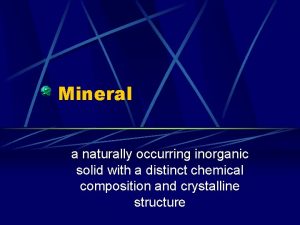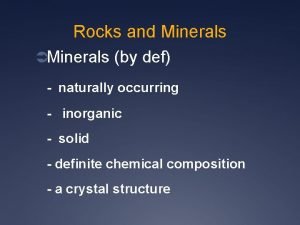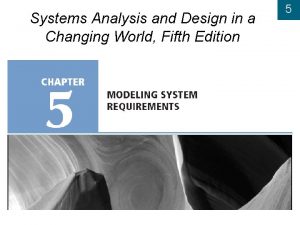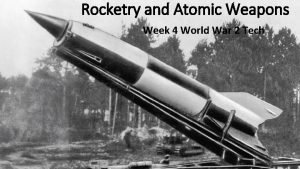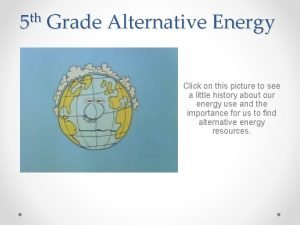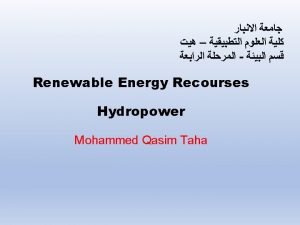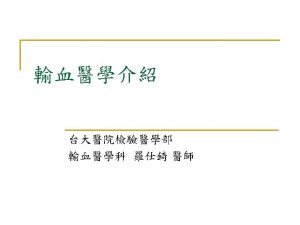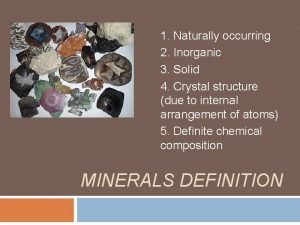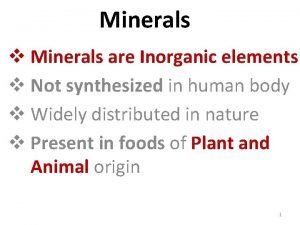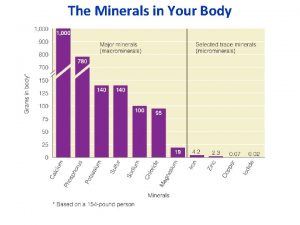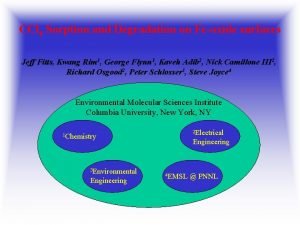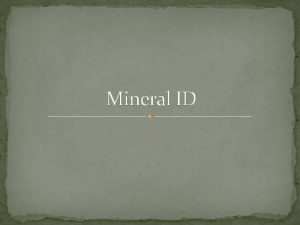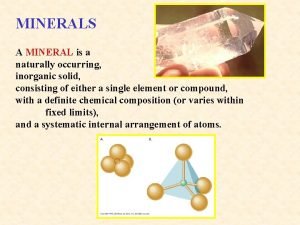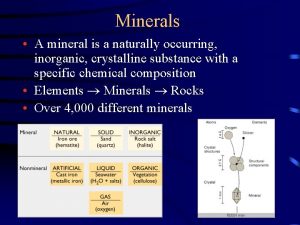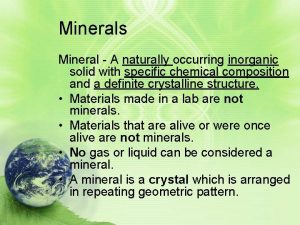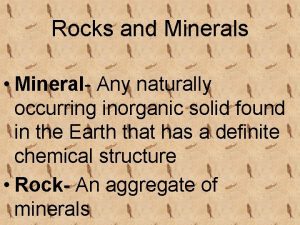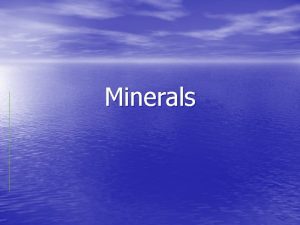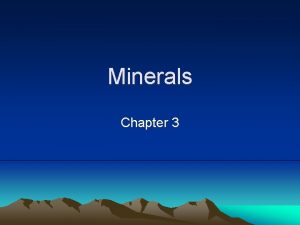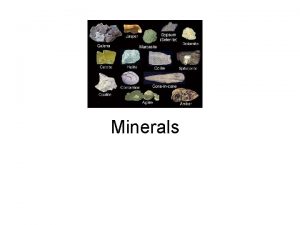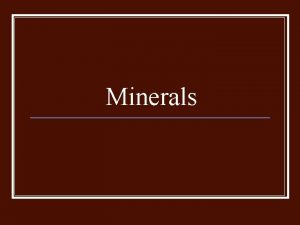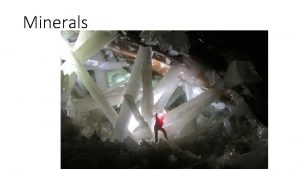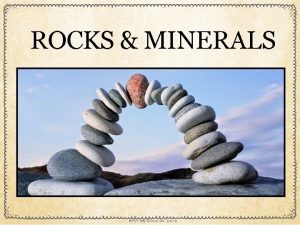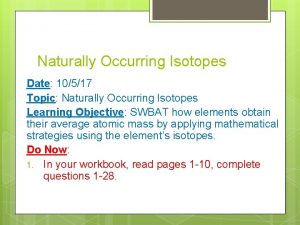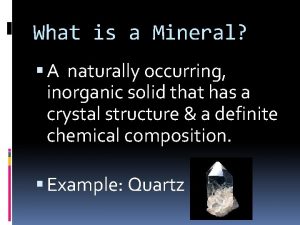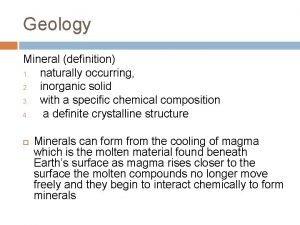MINERAL REROURCES Minerals are naturally occurring inorganic crystalline



















- Slides: 19

MINERAL REROURCES

� Minerals are naturally occurring, inorganic, crystalline solids having a definite chemical composition and characteristic physical properties. � Common minerals quartz, feldspar, biotile, dolomite. calcite, laterite, etc �.

� Minerals find in a large number of ways in every day using domestic agriculture industrial etc… � Development of industrial plants and Michinary � Generation of energy e. g. coal, lignite, uranium. � Construction, housing, settlements. � Defence equipments – weapons, armaments. � Transportation means. � Communication --telephonic wires, cables, electronic devices �.

� Mineral Resource: Any mineral useful to humans � Metallic Minerals: Iron Oxide, Gold � Non-metallic mineral: Limestone, sand � Fossil Fuel; Coal, Petroleum � Ore: A rock that can be profitably mined for a mineral (often a metal) or for minerals (metals) � High Grade Ore; has high concentration of the mineral � Low Grade Ore: smaller concentration � Gangue: rock Minerals other than ore present in a

� Medical System: Ayurvedic system, � Formation of Alloys for various purposes � Agriculture: � Jewelers: Gold, Silver, Platinum � On there properties these are two types � Metallic and Non metallic Minerals

� Distribution and uses of some of the major metallic and non metallic minerals � � Ex: METALS: Alluminium, Chromium, Copper, Iron, Lead, Manganise, Platinum, Gold, Silver, Nickel. � NON-METAL MINERALS: silicate Minerals, Lime Stone, Gypsum, potash, Phosphorite, sulpher pyrites, �

� Minerals are sometimes classified as � Critical � Strategic � Critical minerals are essential for the economy of a nation � Ex: iron , aluminium, copper, gold, etc � Strategic mineral are those required for the defence of a country � Ex: mg, cobalt , platinum etc.

� Some major minerals in India v Energy generating minerals v coal and lignite: westbengal, orissa v Uranium: ap, rajasthan. v Other commercially used minerals v Aluminium: westbengal, tamilnaidu. v Iron: orissa, ap, tn, goa, maharastra v Copper: bihar, wb, mp, ap, uttarakhand.

� More important environmental concern arises from the impacts of extraction and processing of these minerals during mining smelting etc. � Indian scenario: India is the producer of 84 minerals the annual value of which is about 50000 core. At least six major mines need a mention here which are known foe causing severe problem. � Jaduguda uranium mine, Jharkhand-exposing local people to radioactive hazards.

� Jharia coal mines, Jharkhand-underground fire leading to land subsidence and forced displacement of people. � East coast bauxite mine, orissa-land encroachment and issue of rehabitation unsettled. � North-eastern coal fields Assam-very high sulphur contamination of groundwater.

� Surface mining three types � Open –pit: which machines dig holes and remove the ores � Ex: copper, iron, gravel, limestone, sandstone. � Degrading in which chained buckets and draglines are used which scrap up the minerals from underwater mineral deposits. � Strip mining in which the ore is stripped off by using bulldozers, power shovels and stripping wheels. eg: phosphate rocks.

�Surface mining - shallow deposits in US extracts 90% of non-fuel minerals and rocks and 60% of the coal. �Overburden – soil and rock overlying deposit. �Spoils – discarded overburden Open-pit Mining Area Strip Mining

� Subsurface mining - deposits that are too deep for surface mining �Disturbs less �produces less waste �but also less effective and dangerous.


� Environmental damage caused by mining activities 1. Devegetation and defacing of landscape 2. Subsidence of land 3. Ground water contamination 4. Surface water pollution 5. Air Pollution 6. Occupational Health Hazards

� Remedial measures : safety of mine workers is usually not a priority subject of industry. � Statistical data show that on an average, there are 30 non –final but disabling accidents per ton of mineral produced and one death per 2. 5 tone of mineral produced. � The low grade ores can be better utilized by using microbial leaching technique.

� Mining and quarrying in udaipur � About 200 open cast mining and quarrying centers in udaipur � In this place 150 tonnes of explosives are used per month in blasting. � The waste water flows towards a big tank of Bag Dara. � The blasting activity has adversely affected the fauna and the animals like tiger , lion deer and even hare , fox, wild cats and birds

� Mining in Sariska tiger reserve in Aravallis � The Aravalli range is spread over about 692 km in the north-west india covering gujarat , rajasthan, haryana and delhi. � Mining operations within and around the sariska tiger reserve has left many areas permanently infertile and barren. � The precious wildlife is under serious threat.

� Uranium mining in Nalgonda A. P. -the public hearing � The present reserves of uranium in jaduguda mines jharkhand could supply the yellow cake only till 2004. � The Uranium Corporation of India (Ucil)proposed to mine uranium from the deposits in lambapur and peddagattu villages of Nalgonda disrict in andrapradesh and a processing unit at about 18 kms at mallapur. � The IUCL has been trying its best to allure the villagers through employment opportunities.
 Naturally occurring inorganic solid
Naturally occurring inorganic solid Naturally occurring mineral
Naturally occurring mineral Crystalline vs non crystalline
Crystalline vs non crystalline Atomic packing factor of fcc
Atomic packing factor of fcc Insidan region jh
Insidan region jh Largest naturally occurring element
Largest naturally occurring element Is a naturally occurring association among specific things
Is a naturally occurring association among specific things Heaviest naturally occurring element
Heaviest naturally occurring element Naturally occurring fatty acids
Naturally occurring fatty acids Disadvantages of geothermal energy
Disadvantages of geothermal energy Naturally occurring areas of hydrothermal resources
Naturally occurring areas of hydrothermal resources Naturally occurring areas of hydrothermal resources
Naturally occurring areas of hydrothermal resources H
H A narrow channel or slab of a mineral
A narrow channel or slab of a mineral Inorganic mineral definition
Inorganic mineral definition Iron deficiency anemia smear
Iron deficiency anemia smear Enzim
Enzim Crystalline solids
Crystalline solids Ccl
Ccl Mechanical entrapment in gravimetric analysis
Mechanical entrapment in gravimetric analysis
